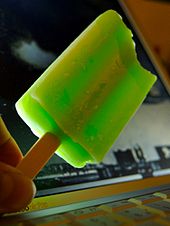- Ice pop
-
An ice pop, also referred to in the United States as a popsicle, and in the United Kingdom as an ice lolly, lolly ice or ice lollipop, is a frozen, water-based dessert. It is made by freezing flavored liquid (such as fruit juice) around a stick. Often, the juice is colored artificially.[1] Once the liquid freezes solid, the stick can be used as a handle to hold the ice pop.
Contents
Terminology
In the United States and Canada frozen ice on a stick generically referred to as a popsicle due to the early popularity of the Popsicle brand, and the word has become a genericized trademark to mean any ice pop, regardless of brand or format. In Ireland the product is also referred to as an ice pop. Ice block is used in parts of Australia[2][3] and New Zealand, as well as icy pole, after a brand of the same name.[4] The term freezer pop or freezie is used for a frozen dessert with no stick, packaged in round plastic sleeves, and in flat plastic sleeves (such as Otter Pops), and eaten by cutting off an end of the sleeve and pushing up the ice.
History
The first recorded ice pop was created in 1905 by 11-year-old Frank Epperson of San Francisco, who left a glass of soda water powder and water outside in his back porch with a wooden mixing stick in it. That night the temperature dropped below freezing, and when Epperson returned to the drink the next morning, he found that the soda water had frozen inside the glass, and that by running it under hot water, he was able to remove (and eat) the frozen soda water chunk using the stick as a handle.[5]
The ice pop was introduced to the public for the first time at an Oakland ball for firemen in 1922. In 1923, Epperson applied for a patent for "frozen ice on a stick" called the Epsicle ice pop, which he re-named the Popsicle, allegedly at the instigation of his children. A couple of years later, Epperson sold the rights to the brand name Popsicle to the Joe Lowe Company in New York City.[6]
Sticks
Ice pop sticks are usually made out of birch wood, sometimes containing hidden riddles written onto their sides.[citation needed]
Homemade ice pops
An alternative to the store bought ice pops is making them at home using fruit juice, drink mix, or any freezable beverage. A classic method involves using ice cube trays and toothpicks, although various ice pop freezer molds are also available. DIY ice pop aficionados pride themselves on the creative flavor combinations they're able to concoct, and many parents prefer having the option of giving their kids cool healthier summer treats than commercially made ice pops.[7]
Consumption
It is estimated that over one billion ice pops are consumed in the United States every year. Out of 30 flavors available, orange has typically been the favorite.[8] However, Popsicle itself claims that its annual sales are over two billion and that its best selling flavor is cherry.[6]
World record
On June 22, 2005, Snapple tried to beat the existing Guinness Book of World Records entry of a 1997 Dutch 21-foot ice pop by attempting to erect a 25-foot ice pop in New York City. The 17.5 tons of frozen juice that had been brought from Edison, New Jersey in a freezer truck melted faster than expected, dashing hopes of a new record. Spectators fled to higher ground as firefighters hosed away the kiwi-strawberry-flavored mess.[9]
Dessert with no wooden stick
A pop (also known as a freezepop/ice-pole,[10] tip top, or cool pop in Ireland[11]) is a snack of frozen flavored sugar water, fruit juice or fruit purée in a plastic tube, either round or flat. Prominent brands include La Fiesta, Californian Snow, Otter Pops, Ice Tickles, Fla-Vor-Ice, Chilly Willy (after the cartoon penguin of the same name), Pop-ice, Foxy Pop, or (in the UK, Ireland, Canada and France) Mr Freeze. Due to the ingredients generally being water and sugar with coloring and flavoring agents, they are said to temporarily discolor the tongue or (less commonly) the teeth. They are produced in a variety of fruit flavors. In Canada they are known almost exclusively as 'freezies'.[12]
See also
- Ice cream
- Paleta — a Latin American ice pop usually made from fresh fruit
- Pudding Pops
- Sorbet
References
- ^ "Hawkeshealth.net". Hawkeshealth.net. http://www.hawkeshealth.net/community/showthread.php?t=6565&page=1. Retrieved 2011-10-06.
- ^ "Ice block". Encarta Dictionary. MSN Encarta. Archived from the original on 2009-10-31. http://www.webcitation.org/5kwrBydAk. Retrieved 2008-12-30.
- ^ "Skybomber 1.63 Litre 24 Pack Ice Blocks". Products. Dairy Bell Ice Cream. http://www.dairybell.com.au/products.php?producttype=P&prodid=23. Retrieved 2008-12-30.
- ^ "Nestlé Peters Icy Pole". Ice Cream Products. Nestlé Australia. http://www.nestle.com.au/OurProducts/Cat/Ice_Cream/Icy_Pole.aspx. Retrieved 2010-10-08.
- ^ "Hall of Fame". Archived from the original on 2010-11-15. http://web.archive.org/web/20080608063504/http://www.thekidshalloffame.com/CustomPage15.html.
- ^ a b "The Popsicle Story". Popsicle. http://www.popsicle.com/The-Popsicle-Story.aspx.
- ^ "10 Delicious, All-Natural Homemade Ice Pop Recipes". Planet Green. http://planetgreen.discovery.com/food-health/10-delicious-all-natural-homemade-ice-pop-recipes.html.
- ^ "Kid Inventors in History". Kidzworld. http://www.kidzworld.com/article/1010-kid-inventors-in-history.
- ^ "Disaster on a stick: Snapple’s attempt at popsicle world record turns into gooey fiasco". MSNBC. 2005-06-22. http://www.msnbc.msn.com/id/8321110/. Retrieved 2007-06-29.
- ^ Morrison, Ewan (2008-11-23). "The ice-cream van's jingle-jangle freezes me with a mixture of fear and adrenalin". Scotland on Sunday. http://scotlandonsunday.scotsman.com/12700/Ewan-Morrison-39The-icecream-van39s.4722420.jp. Retrieved 2008-12-06.
- ^ "Robert Roberts Limited Mr. Freeze - Ireland's No. 1 Cool Pop". http://www.robert-roberts.ie/cms_rr/index.php?page=mr-freeze.
- ^ "Urban Dictionary: Freezie". Urban Dictionary. http://www.urbandictionary.com/define.php?term=Freezie. Retrieved 2010-04-05.
Categories:- Snack foods
- Frozen desserts
- Skewered foods
- California culture
- Cuisine of the Western United States
- Cuisine of the San Francisco Bay Area
Wikimedia Foundation. 2010.

